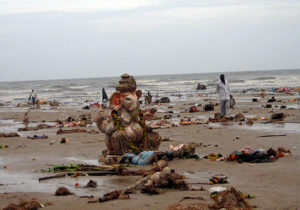Today happens to be the last day of the Ganapati festival. Especially in Maharashtra, and more so on Mumbai, the festival is celebrated with such pomp and fervour that it would amaze anyone. Speaking from a religious hat, Ganesha, the benign elephant god after visiting tera firma for some ten days, will now be returning to good heavenly abode, among energetic chants of “Ganpati Bappa Morya, Puchta Varshi Lavkar Ya” (All hail Ganapati. Please come early next year). There such an energy that flows through the city, that it envelops you and affects you. Witnessing all the myriad Ganeshas being taken out for visarjan (ritualistic immersion), amid chants, drums and flowers, it’s hard not to feel happy and charged up at the same time.
But sadly this feeling doesn’t really for long. Over the next few days, one will be confronted with the scale of mindless degradation, of the  water bodies, of grounds, it saddens you a quite a bit. Newspapers will publish photos of washed up idols of Ganesha strewn across the beaches of Mumbai. A few familiar voices that try to leverage every thing for a personal PR, will suddenly appear on the scene and start with their familiar spiel of how the city is unable to cope with the sheer scale of the festival, they will ramble about the destruction of mangroves, of beaches, of the Arabian sea, and once they have got their 15 mins, they will shut up and into in hibernation.
water bodies, of grounds, it saddens you a quite a bit. Newspapers will publish photos of washed up idols of Ganesha strewn across the beaches of Mumbai. A few familiar voices that try to leverage every thing for a personal PR, will suddenly appear on the scene and start with their familiar spiel of how the city is unable to cope with the sheer scale of the festival, they will ramble about the destruction of mangroves, of beaches, of the Arabian sea, and once they have got their 15 mins, they will shut up and into in hibernation.
This whole environmental/ecological discussion has almost turned into a cycle, the narrative moves along familiar ways. It isn’t that the people at large have been oblivious or ignorant to the ecological impact of the visit by the celestial god. The immersion prices gas been largely streamlined, you can’t just immerse the idol anywhere that catches your fancy. There are designated points, there’s a process, and more importantly, there are people from the administrative side that oversee and conduct the whole process. Over the past couple of years, the judiciary too has done it’s bit in bringing some necessary checks and balances, the high court especially has been quite proactive in clamping down on noise pollution, or pulling up the government for shoddy work done.
On the common folks level, people have become sensitive and concerned about how the commonly available plaster-of-Paris (p-o-p) idols truly besmirch the lakes, rivers and the sea. Idols crafted with mud (Shadu mitti) are costlier but quite common. There are now idols that are available that dissipate into a potted plant, once the festival passes. Even the media, more so the FM radio channels drive home the point quite laboriously through many days before the festival.
 Personally, I have grappled with such issues myself, thrice has the elephant god visited my place, making me aware of the kind of challenges that present themselves, even when you are willing and keen to go green. While my first idol was a p-o-p one, the next two were of shadu mitti. Ideally, that should be making me happy and glad, as I seem to have have done my bit by going the “eco” way. But I frankly am not.
Personally, I have grappled with such issues myself, thrice has the elephant god visited my place, making me aware of the kind of challenges that present themselves, even when you are willing and keen to go green. While my first idol was a p-o-p one, the next two were of shadu mitti. Ideally, that should be making me happy and glad, as I seem to have have done my bit by going the “eco” way. But I frankly am not.
It’s only when, we started bringing in Ganesha at home, did I realise the scale of issues that confronts you. Greening in the idol is just one aspect of the festival, there’s much that needs to be done on that front.
Especially this year, I started to make notes of the environmental impact or rather the CO2 footprint of the Ganapati fest. In fact, we even tried to go in for eco-products in our quest to go green. It was costlier, but felt good. Yet, it is really not enough.
To give you an idea, let me enumerate with a few thoughts.
Beginning with the idol, while many people are now going in for eco-ganeshas (made of mud/clay) we embellish the idol in not-so ecological paints. The idols are painted in vivid colors, and accessorized with glassy objects that are anything but eco. In fact, idolly — or ideally, the idol must be in the pristine condition that it is made, with a natural color that manifests itself. While there could artistic refinements, there should be minimal embellishment of the idol itself. Continue reading
